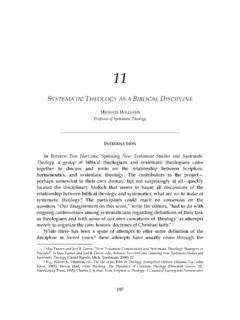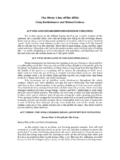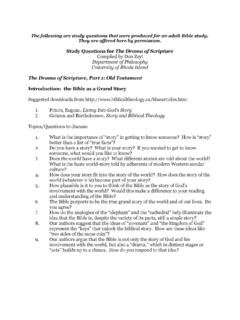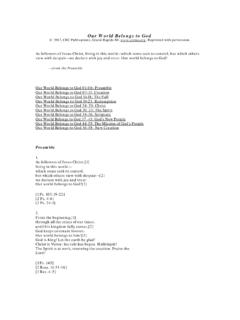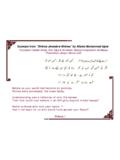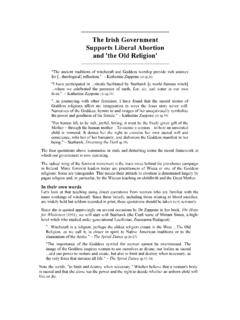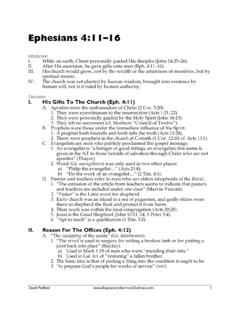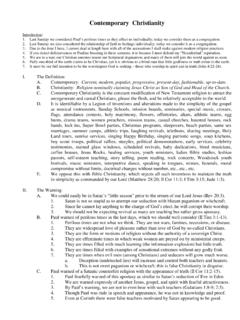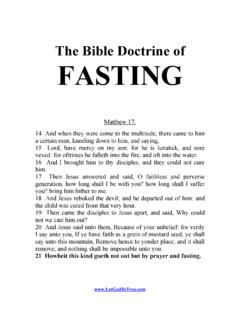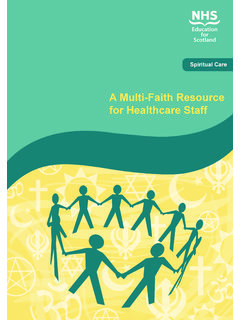Transcription of THE BOOK AND THE STORY - biblicaltheology.ca
1 THE book AND THE STORY N. T. Wright(From The Bible in TransMission, Summer 1997) In the last edition of TransMission, Bishop Lesslie Newbigin wrote about the importance of recovering the whole biblical canon as a source of objective authority and truth in contemporary culture. Any church concerned with mission will be aware that there are different, conflicting world view between the Christian faith and wider society which must be faced and engaged with. Here, Tom Wright explores the nature of the over-arching biblical narrative and how it subverts and challenges the world view of our surrounding culture. It is adapted from the opening address given at The Open book consultation Imagining Tomorrow at the Hayes Conference Centre, Swanwick, January 1997.
2 In the Christian canonical Bible there is a single over-arching narrative. It is a STORY which runs from creation to new creation. The great bulk of the STORY focuses quite narrowly on the fortunes of a single family in the Middle East. They are described as the people through whom the creator God will act to rescue the whole world. The choice of this particular family does not imply that the creator has lost interest in other human beings or the cosmos at large; on the contrary, it is because he wishes to address them with his active and rescuing purposes that he has chosen this one family in the first place. Even if we were to rearrange the Old Testament canon (adopting the normal Jewish order, for example, in which the Prophets precede the Writings, ending with 2 Chronicles instead of Malachi) we would still be reading a STORY in search of an ending, in which the people chosen to bring the creator s healing to the world are themselves in need of rescue and restoration.
3 First and Last The New Testament declares with one voice that the over-arching STORY reached its climax in the life, death and resurrection of Jesus of Nazareth, whom the early Christians believed to be the promised Messiah of Israel. The followers of Jesus saw themselves as royal heralds, claiming the whole world for its new king. Although it is rightly said that the first Christians saw themselves as living in the last days, it is even more important to stress that they were living in the first days of a new creation that dawned when Jesus emerged from the tomb on Easter morning. In other words, they saw themselves living within a STORY in which the decisive event had already occurred and now needed to be implemented. That is the implicit narrative which informs and undergirds all the epistles.
4 The four canonical gospels, in their very different ways, are only comprehensible if we understand them to be telling how the STORY of God and Israel reached its climax in Jesus. Even if we were to rearrange the New Testament canon, this implicit STORY -line would emerge at every point. Community From this brief sketch it is possible to see how the Bible (Jewish or Christian) does not exist, and does not offer itself to us, as a detached set of writings or as a book -in-a-vacuum. It is our window on a reality which is decidedly extra-textual a complex community stretching from Abraham to the early apostles. In particular, the Christian Bible is a window on a particular extra-textual reality, the human being Jesus of Nazareth, whose followers came to believe in an astonishingly short space of time that he was the living, human embodiment of the one true God of Israel, the God of Abraham, Isaac and Jacob.
5 The New Testament is not free-standing. It is what it is because it points away from itself, to the One God of Jewish monotheism who is now known in Jesus of Nazareth and the events of his life, death, resurrection and the outpouring of his Spirit on his followers. If the Bible, Jewish and Christian, does not refer to these extra-textual realities, it fails in its whole object. The biblical writers referred to the actual STORY of the creator and his world, focused on the STORY of the creator of Israel, on the STORY of Jesus and Israel, and on the STORY of Jesus followers and the cosmos. In other words, whatever view of the Bible you take, if you are to be in any way obedient to the Bible you cannot make the Bible itself the centre or focus of your attention.
6 It points away from itself. From the Christian point of view, the centre of attention can never be merely the Bible; it must always be Jesus of Nazareth, Jesus the Messiah, Jesus the Lord of the World. A Clash This point is reinforced if the situation of the early Church is considered in the days before there was such a thing as the New Testament. The expansion, development and consolidation of early Christianity did not take place primarily through writing (Paul s letters are, perhaps, a partial exception). They took place through people, through a community which worshipped the God of Israel and recognised him in the human face of Jesus. This community ordered their lives and their symbolic universe on the basis that they were not only the renewed Israel but also the renewed human race.
7 The conflict that this community experienced, both with Jews who did not believe Jesus to be the Messiah, and, more especially, with pagans who saw the proclamation of Jesus as Lord to be a threat to their status quo, can be explained in terms of a clash of narratival and symbolic universes. This clash, and the ways in which Christians engaged in dialogue and mission, was much greater than merely a clash between their writings (or those writings which became the New Testament) and their surrounding culture. It was a clash between a community with its entire symbolic and narratival world view and other, surrounding communities with theirs. In focusing on the Bible and its interface with contemporary culture we dare not forget that it is part of, and indicative of, a wider whole.
8 Once we grasp this point about the clash of world views, it is easy enough to understand how the interface between the Bible and our own contemporary culture still bears a good deal of family likeness to the interface between early Christianity and its surrounding milieu. When we read the Bible in its own terms, as an overarching STORY , we soon discover that this metanarrative challenges and subverts several other world views. A Challenge to Paganism From creation to recreation, from the call of Abraham to the New Jerusalem, what the Bible offers presents itself as the truth of which paganism is the parody. Paganism sees the glory of creation, and worships creation instead of the creator. The grown-up version of this, of course, is pantheism, whether Stoicism in the ancient world or the varieties of New Age belief in the contemporary world.
9 The mirror image of this is dualism, the belief that creation is the work of a lesser god or an anti-god. One of the remarkable things about the Bible is the way in which, from Genesis to Revelation, these options are systematically refused. There is One God, the creator; creation is good, but it is not God; the reality of evil in the world is not to be explained in terms of either an evil creation or an evil god, but as an intrusion into the good creation, which is dealt with through the STORY of the chosen family. This biblical challenge to paganism and dualism is huge and basic, and is presupposed in all that follows. A Challenge to Idealism The biblical metanarrative challenges and subverts the world view of idealism, in which historical events are mere contingent trivia, and where reality is to be found in a set of abstractions, whether timeless truths or absolute values.
10 Any attempt to see the biblical STORY in this way is confronted by the biblical text itself, in which the opposite is the case. The love, justice and forgiveness of God are not invoked in the Bible to draw attention away from the historical sphere, but rather to give it meaning and depth. When Israel invokes the justice of God, she wants to be liberated from her enemies. When the early Christians spoke of the love of God, they were referring to something that had happened in recent history, and which had changed the way the real world not just their real world, but the real world actually was. A Challenge to the Aphoristic World The biblical metanarrative also challenges and subverts the non-storied aphoristic world of The Gospel of Thomas as well as contemporary post-modernity.
